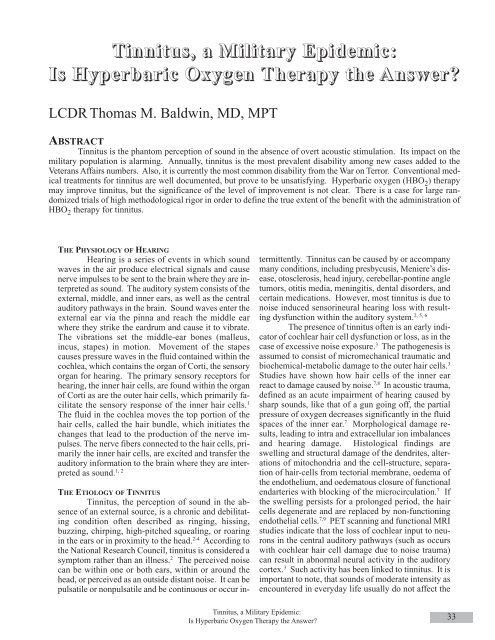Summer - United States Special Operations Command
Summer - United States Special Operations Command
Summer - United States Special Operations Command
Create successful ePaper yourself
Turn your PDF publications into a flip-book with our unique Google optimized e-Paper software.
Tinnitus, a Military Epidemic:Is Hyperbaric Oxygen Therapy the Answer?LCDR Thomas M. Baldwin, MD, MPTABSTRACTTinnitus is the phantom perception of sound in the absence of overt acoustic stimulation. Its impact on themilitary population is alarming. Annually, tinnitus is the most prevalent disability among new cases added to theVeterans Affairs numbers. Also, it is currently the most common disability from the War on Terror. Conventional medicaltreatments for tinnitus are well documented, but prove to be unsatisfying. Hyperbaric oxygen (HBO 2 ) therapymay improve tinnitus, but the significance of the level of improvement is not clear. There is a case for large randomizedtrials of high methodological rigor in order to define the true extent of the benefit with the administration ofHBO 2 therapy for tinnitus.THE PHYSIOLOGY OF HEARINGHearing is a series of events in which soundwaves in the air produce electrical signals and causenerve impulses to be sent to the brain where they are interpretedas sound. The auditory system consists of theexternal, middle, and inner ears, as well as the centralauditory pathways in the brain. Sound waves enter theexternal ear via the pinna and reach the middle earwhere they strike the eardrum and cause it to vibrate.The vibrations set the middle-ear bones (malleus,incus, stapes) in motion. Movement of the stapescauses pressure waves in the fluid contained within thecochlea, which contains the organ of Corti, the sensoryorgan for hearing. The primary sensory receptors forhearing, the inner hair cells, are found within the organof Corti as are the outer hair cells, which primarily facilitatethe sensory response of the inner hair cells. 1The fluid in the cochlea moves the top portion of thehair cells, called the hair bundle, which initiates thechanges that lead to the production of the nerve impulses.The nerve fibers connected to the hair cells, primarilythe inner hair cells, are excited and transfer theauditory information to the brain where they are interpretedas sound. 1, 2THE ETIOLOGY OF TINNITUSTinnitus, the perception of sound in the absenceof an external source, is a chronic and debilitatingcondition often described as ringing, hissing,buzzing, chirping, high-pitched squealing, or roaringin the ears or in proximity to the head. 2-4 According tothe National Research Council, tinnitus is considered asymptom rather than an illness. 2 The perceived noisecan be within one or both ears, within or around thehead, or perceived as an outside distant noise. It can bepulsatile or nonpulsatile and be continuous or occur intermittently.Tinnitus can be caused by or accompanymany conditions, including presbycusis, Meniere’s disease,otosclerosis, head injury, cerebellar-pontine angletumors, otitis media, meningitis, dental disorders, andcertain medications. However, most tinnitus is due tonoise induced sensorineural hearing loss with result-2, 5, 6ing dysfunction within the auditory system.The presence of tinnitus often is an early indicatorof cochlear hair cell dysfunction or loss, as in thecase of excessive noise exposure. 3 The pathogenesis isassumed to consist of micromechanical traumatic andbiochemical-metabolic damage to the outer hair cells. 3Studies have shown how hair cells of the inner earreact to damage caused by noise. 7,8 In acoustic trauma,defined as an acute impairment of hearing caused bysharp sounds, like that of a gun going off, the partialpressure of oxygen decreases significantly in the fluidspaces of the inner ear. 7 Morphological damage results,leading to intra and extracellular ion imbalancesand hearing damage. Histological findings areswelling and structural damage of the dendrites, alterationsof mitochondria and the cell-structure, separationof hair-cells from tectorial membrane, oedema ofthe endothelium, and oedematous closure of functionalendarteries with blocking of the microcirculation. 7 Ifthe swelling persists for a prolonged period, the haircells degenerate and are replaced by non-functioningendothelial cells. 7,9 PET scanning and functional MRIstudies indicate that the loss of cochlear input to neuronsin the central auditory pathways (such as occurswith cochlear hair cell damage due to noise trauma)can result in abnormal neural activity in the auditorycortex. 3 Such activity has been linked to tinnitus. It isimportant to note, that sounds of moderate intensity asencountered in everyday life usually do not affect theTinnitus, a Military Epidemic:Is Hyperbaric Oxygen Therapy the Answer?33
















